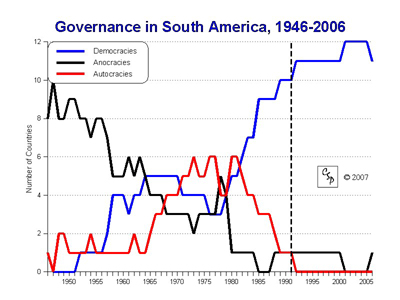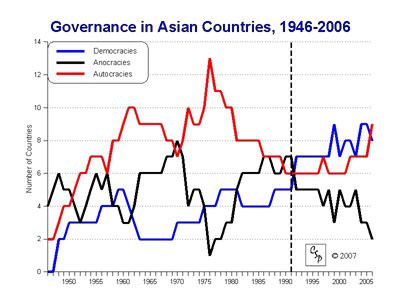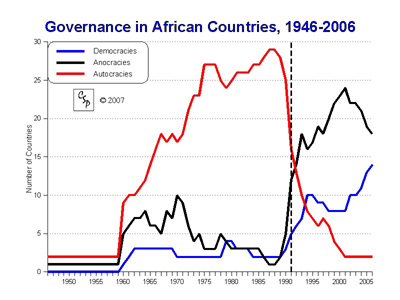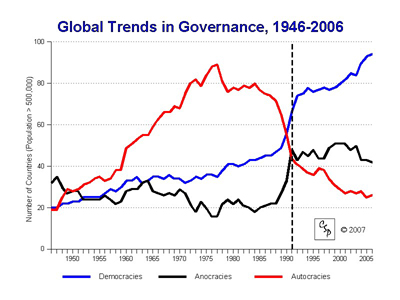 The Global System and Comparative Regionalism
The Global System and Comparative Regionalism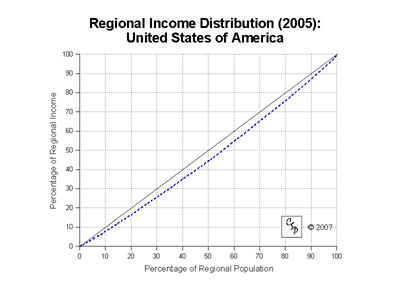 |
Regional Sub-System: United States of America |
|
Armed Conflict in the USA: Almost none since 1946
("Ghetto-riots" resulted in major political violence, 1963-65) |
Governance in the USA: Highly Institutionalized
Democracy (+10) since 1871
|
|
The United States is often touted as a superior
example of societal-system performance. Since the end of
the Cold War and the dissolution of the Soviet Union, it has also been
commonly referred to as the world's "leading democracy" and
only "superpower." Whereas serious questions remain as to
whether the United States serves as an attainable, or sustainable, model
for the aspirations of other states, regional sub-systems, or the global
system as a whole, the United States does exhibit unquestionable levels
of achievement in many aspects of complex societal-system performance.
Among its achievements are a leading role in global technological progress;
high levels of societal integration and the continuing integration of
minority groups; stable democratic institutions of governance at all
levels of administration since 1871; almost no major, intra-state, political
violence since 1946 (and low levels since 1865); and the world's highest
level of income among major societal-systems. Perhaps most remarkable
is the almost perfect equality of incomes among its fifty + one constituent,
federal states (see Lorenz curve above). |
|
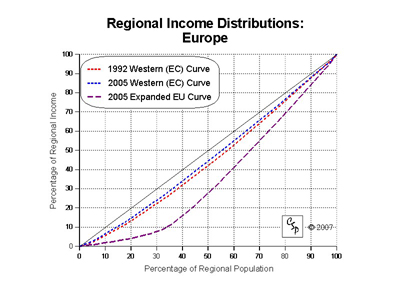 |
Regional Sub-System: European Union |
 |
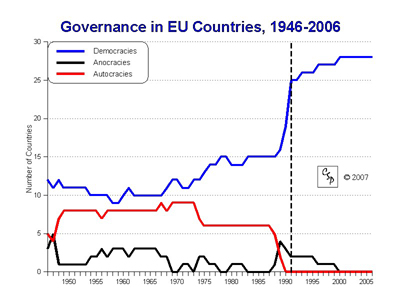 |
|
Western Europe provides a second example of a well-performing
regional societal-system. Emerging from the dismantling of
the Euro-centric imperial world system following the catharsis of the
Second World War, the eleven Western European states have been able
to transform their regional societal-system to allow greater systemic
integration and follow the example of the United States to approximate
that system's high level of performance. The regional profile for the
Western Europe sub-system (i.e., states that formed the original European
Community) shows a high degree of income equality among constituent
units that has continued to improve since 1958. The profile of income
distribution (above) plots Lorenz curves for 1992 and 2005 for Western
Europe (the two curves closest to the "line of equality").
In addition, the diagram plots the 2005 Lorenz curve for the expanded
European Union (twenty-eight units, including the three candidate countries
Croatia, Macedonia, and Turkey). Expansion into Eastern Europe, especially
the accession of Turkey with its large and relatively poor population,
dramatically alters the income distribution of the regional system.
This illustrates one of the sources of tension that has characterized
accession negotiations with Turkey over the past several years and has,
more generally, increased debate and disagreement among the key states
in the European Union over tighter policy and financial integration
(not to mention a strong, zenophobic reaction among nationalists). We
argue that high degrees of internal trade and exchange among
constituent units in a system serve to equalize income among units over
time; this process is strengthened by redistributive policies enacted
by central administration in strongly integrated societal-systems. Indeed,
in the US and European regional systems, the volumes of trade and transactions
among constituent units are much higher than the volume of trade and
transactions with units outside the regional system. |
|
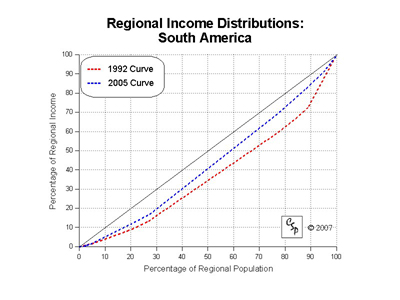 |
Regional Sub-System: South America |
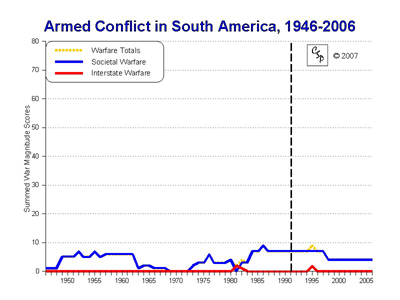 |
|
|
A third example of a reasonably well-performing
regional system is found in South America. The systemic distribution
curves for South America show substantial improvement in income distribution
among the countries of that region, particularly due to improved economic
performance in Brazil, despite general instability triggered by the
2001 financial crisis in Argentina. As mentioned, this region has experienced
relatively low levels of political violence during the contemporary
period and has witnessed a resurgence and consolidation of democratic
governance since the end of the Cold War (only Venezuela scores lower
than +6 on the Polity scale; its regime rating dropped to anocracy
due to a further concentration of executive power under President Chavez's
initiative to create a one-party state). On the other hand, only Chile
(beginning in 2006) and Uruguay are rated as "fully institutionalized
democracies" (with Polity scores of +10). Similar to the
US and European regions, South America has a relatively high density
of trade and transactions among its constituent units. One corollary
of the 2001 financial crisis is that income growth for the region has
fallen behind the standard set by the Western European countries (-5.5%).
Income distributions within states in the South America region are also
more unequal than those in Western Europe and the United States; Gini
Indices for South American states range from a low of 43.2 in Guyana
to a high of 59.1 in Brazil. This skewed distribution of income within
South American countries sets the basis for the strong and pervasive
movement toward democratic populism across this region during the first
decade of the new millennium.In the past, such populist pressures often
triggered a forceful and autocratic response from an alliance between
a politicized military and economic elites. So far, since the end of
the Cold War, South American militaries have been less willing to engage
actively in regulating political authority. |
|
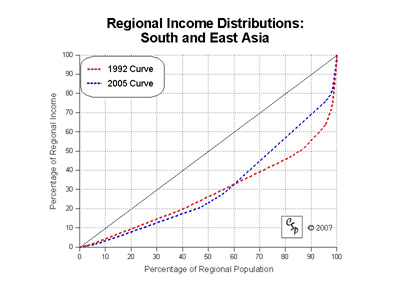 |
Regional Sub-System: South and East Asia |
 |
|
|
Middle-performance regional systems are found in
Central America and Asia. The Central America (not shown)
and Asia regional subsystems show moderate integration. The Asia regional
profile provides an example of a historically less well-performing sub-system,
but one which has made substantial progress in the post-Cold War, globalization
era. It is home to some of the world's largest and most densely populated
countries and in 1992 it had the lowest GDP per capita of all the world's
regional sub-systems; even lower than sub-Saharan Africa. (The well-performing
island states of Australia, Japan, and New Zealand are not included
in this analysis of the Asia regional system; there is no data for Myanmar,
North Korea, or Taiwan.) The Asia region has experienced fairly high
levels of armed conflict throughout the contemporary period, and before
(it was a major arena of the Second World War). It is unique in that
the overall level of armed conflict has not fallen much with the end
of the Cold War. While warfare has diminished substantially in East,
Central, and Southeast Asia, it remains relatively high in South Asia
(home, also, to the world's poorest nuclear powers). Asia is also home
to some of the world's most reclusive states, including Bhutan, Laos,
Myanmar (Burma), and |
|
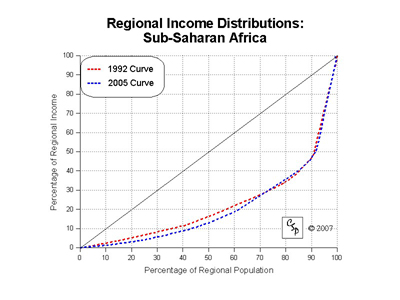 |
Regional Sub-System: Sub-Saharan Africa |
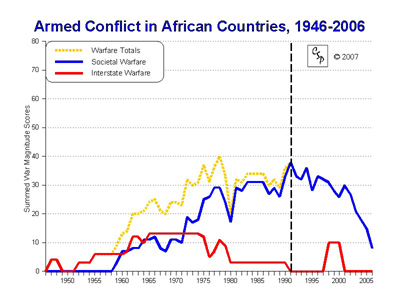 |
|
|
The world's poorest performing regions are those
in Sub-Saharan Africa and the forty-one countries comprising the swath
of Muslim Countries extending from the northwest coast of Africa to
the Indonesian archipelago. The most troubling regional sub-systems
in the globalization era are the region constituted by the sub-Saharan
(non-Muslim) African countries and that of the pre-dominantly Muslim
countries (i.e., countries in which 50% or more of the population professes
an Islamic faith). The Lorenz curves for these two regional systems
are (surprisingly) roughly equivalent; income inequality among African
countries is only slightly greater than income inequality among Muslim
countries. |
|
 |
Regional Sub-System: Muslim Countries |
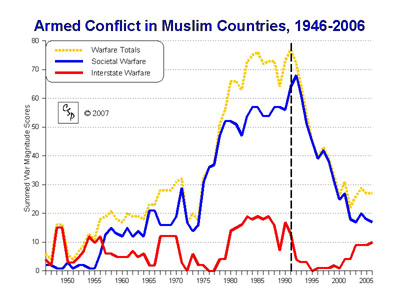 |
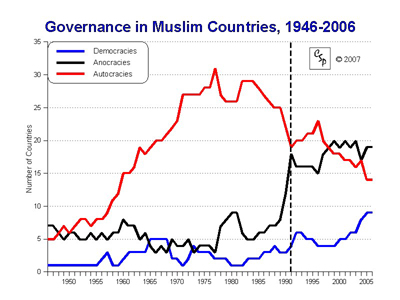 |
|
The poor-performing regional system comprised
by the world's Muslim Countries causes the greatest concern as it has
the strongest extra-regional tie-ins due to its expanse across the Eastern
Hemisphere, large population, and possession of vast, and highly coveted,
oil reserves. Generally, when we consider the Muslim countries,
our interest is strongly influenced by a preoccupation with the region's
relatively wealthy, oil-producing states and the protracted Arab-Israeli
conflict. Consideration of the region's grinding poverty and seriously
unequal, systemic distribution of income is often ignored or overlooked
as major contributors to the region's past and present volatility, and
future prospects. (This region overlaps with the Asia region analyzed
above; both regions include Afghanistan, Bangladesh, Indonesia, and
Pakistan. In addition, the European Union region shares Turkey with
the Muslim Countries region.) The Muslim Countries have experienced
the highest levels of armed conflict, both societal and interstate,
of all the world's regional systems during the contemporary era. Regional
armed conflict levels grew especially high in the late 1970s, continuing
through the end of the Cold War. Levels quickly diminished by over 80%
in the 1990s but have showed signs of resurgence in the past few years,
particularly due to an increase in interstate war associated with the
"al Qaeda" movement. The Muslim Countries comprise the only
region to show a substantial increase in general levels of warfare in
the new millennium. The Muslim region has been ruled for much of the
contemporary period by strongly autocratic regimes; democratic experiments
have been relatively rare and usually short-lived. The Muslim region
has the highest number of autocratic regimes in early 2007 (fourteen).
Regime type is associated with patterns of oil production: twelve of
the Muslim autocracies are net oil producers (only two autocracies remain
among the non-oil producing Muslim countries; these are Uzbekistan and
Morocco). There are no democracies among the net oil-producing states
in either the Muslim or African regions. In 2007, there were eight democracies
in Muslim countries (scoring +6 or more on the Polity scale).
Muslim democracies, such as Indonesia, Senegal, and Turkey, dot the
periphery of the region. Regional income in the Muslim Countries region
is substantially higher than that of the African region and has increased
by ten percent relative to Western Europe between 1992 and 2005, seeming
to narrow the "income gap" somewhat. This apparent improvment
in regional development is accounted for by the dramatic increase in
oil revenue; without this factor, relative income growth would be stagnant
at best. Despite the relative increase in income from oil, the region
shows a worsening income distribution among constituent states during
the globalization era. Of even greater concern is the fact that levels
of formal trade and transactions among the states within the Muslim
region, as in Africa, are extremely low and show few signs of improvement.
Inter-regional trade in each region accounts for between five and fifteen
percent of total trade. These regions remain heavily dependent on extra-regional
export trade in primary commodities; manufactured goods account for
less than twenty percent of total export trade. |
|
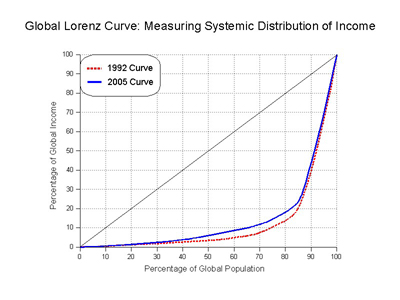 |
The Global System |
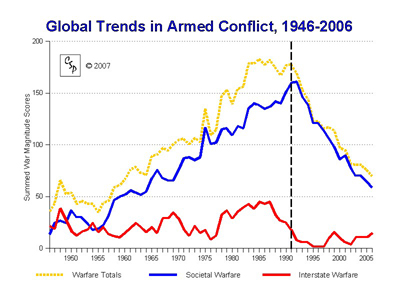 |
|
|
(Re)considering the Global System and the Prospects
for Effective Global Governance. The global system as a whole
is an emerging societal-system that is highly complex and poorly understood;
it is much more than the sum of its parts. This report hopes to establish
baseline conditions as a starting point for better understanding the
prospects for stability and change in the global system.The discussion
above brings together regional profiles of the "parts" of
the system in order to gain a comparative perspective on "relative
income" and "relative growth" among the regional sub-systems
that comprise the global system. The income distribution profile for
the global system, then, presents a very real sense of "shock and
awe" of the challenges and opportunities confronting political
leaders in the early years of the emerging "globalization era."
The global system as a whole is a societal-system in which income production
is highly concentrated and centralized; a system that is profoundly
split into "Haves" (about 15% of the global population) and
"Have-nots." As of 2005, eighty percent of the population
accounted for less than twenty percent of formal production income.
It would seem that the potential for polarization and factionalism in
such a system is quite high and, given the evidence that the "income
gap" is narrowing only slowly if at all, will remain high for the
foreseeable future. The policy implications of this examination can
be summarized in a single phrase: extreme caution.
The information and communication revolutions have created powerful
tools that, like all tools, act as "double-edged swords":
they enable and empower not only the world's elites and the advocates
of globalization but also the demagogues of discontent and disintegration.
If there is one thing that most clearly distinguishes the globalization
era from preceding eras, it is the speed of and potential for social
mobilization. Opportunities for freedom and growth are created when
policy effectiveness and political legitimacy stand together; serious
challenges are created when they drift apart or, worse, when they fall
in unison. The United States has grown slightly wealthier per capita
than Western Europe in this period, as have Central America, and the
Muslim Countries. However, the more striking trends are the remarkable
relative growth in Asia, driven by China's emergence as a major economic
power, and the relative declines in income in South America and sub-Saharan
Africa. The emerging era of globalization begins, then, with three important
challenges: One is the sharply increasing number of 'anocracies,' which
denote a transitional and potentially unstable stage on the way to more
stable democratic governance (or state failure). A second is the large,
and in many cases growing, gap in income among countries within the
world system, and within certain regional sub-systems. A third is the
disruptive potential of growing dependence of the wealthier countries
on petroleum (and the corollary, but as yet unknown, effects of global
climate change); this too needs to be accepted as an imperative, global
dilemma, requiring a cooperative and coordinated global solution. The
top priority for Global Governance must be the promulgation of a comprehensive
global energy policy.Given the severely unequal distribution
of income in the global system, the prospects for even greater systemic
polarization are profound and, with it, the prospects for autocratic
relations based on power discrepancies among constituent states, the
dangers of military confrontation and war, and arrested and distorted
systemic development. The challenges to peace are enormous. In order
to manage these challenges, the will to peace must be boundless, and
fearless in speaking truth to power. Peace is not a gift nor an idyllic
state of being, it is the logical result of an educated, informed, and
innovative population, proactively engaged at all levels of societal-systemic
organization, who reject force, violence, and war in the pursuit of
opportunities, resolution of disputes, and solution of problems. |
|
Click here to return to the Global Conflict Trends Page
or on the CSP icon below to return to the CSP Home page.
 |
